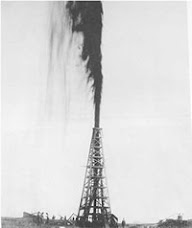
Yesterday, I was buying E&P (exploration and production) stocks as they took a tumble of 2% to 4%. Talking heads are blaming low natural gas prices, which fell 3% yesterday. However, I suspect that the E&P bull market may be over. Most of these stocks barely react to positive news and are significantly weak on negative news. As I warned in the past, the DJIA as the driver of E&P stocks now appears to be failing. It may be a whole new ballgame.
Williston Basin stocks that I bought yesterday are Brigham Exploration (BEXP) at $15.59 and Continental Resources (CLR) at $37.33. I bought natural gas E&P firm Petrohawk (HK) at $19.57. All of three of these are doubling down on positions that I already hold.
Drilling Services Industry: Yesterday, I looked at contract drilling firms, the firms that E&P companies hire to actually drill the wells. This is a very cyclical business.
The demand for drilling rigs today is largely limited to rigs that can drill horizontal wells in shale plays. These “unconventional” rigs are best described as new (or recently rebuilt) big, electric rigs with top drives that are equipped for underbalanced drilling.
Today and for the next few months, at least, unconventional rigs can find work. Conventional rigs are in such oversupply that many of them are idle. Drilling contractors are rapidly converting conventional rigs to become unconventional capable. So the supply of horizontal-capable rigs is increasing.
Yesterday, drilling contractor stocks were in full retreat, I looked at three of them: Helmerich & Payne (HP), market capitalization = $3.8 billion; Pioneer Drilling (PDC), MktCap = $378 million, and tiny Union Drilling (UDRL), MktCap = $134 million. HP and PDC have some international operations, some non-drilling operations, and still have significant number of unconventional rigs. Normally HP is the only of these stocks that I follow.
Union Drilling (UDRL) is tightly focused on the kind of shale plays that I’m interested in. It has no international operations and no non-drilling operations. 55 of its 71 rigs are unconventional rigs. Yesterday in the last five minutes of trading, I tried to buy UDRL at $5.80 but only got a fraction of the shares that I wanted. Union Drilling is very thinly traded; always place a limit order. Had I placed a market order, I easily could have paid $6.20 or much higher for the remaining shares.
Exciting Market Close: E&P stocks vacillated all day but hinted at a buying opportunity. At 3:30 EDT, with only 30 minutes left, the DJIA began sinking, and driving E&P stocks into a panic. What is strange is that the DJIA ended almost unchanged, but E&P stocks were down 2% to 4%, mostly in the last 30 minutes.
By 3:45, several stocks were in my buying range. After that, I was so busy making and modifying orders that I was caught unaware at 4:00 that the market had closed. I made all four of the trades described above in the last 5 minutes of trading.
I made two minor mistakes. I bought twice as much Continental Resources as I had intended to, and I put my Union Drilling order in at 3:58 when it had very little chance of completely filling. Had I stuck to my rule to follow only a few stocks and to focus on only one or two in any given day, I would not have erred. But these are tiny mistakes, and providence always intercedes in my favor.
This is the only excitement that the market has provided in the last two weeks.
Recommendations: I am still 90% in cash. In fact, Wednesday I bought more TIP fund at $103.30; TIP owns treasury inflation protected securities. I am still waiting for a major pullback in E&P stocks and am preserving most of my cash for that. However, I can’t be assured that the pullback will come. Thus I’m making selective investments.
In addition to the stocks that I mentioned above, I’m looking for buying opportunities in Quicksilver (KWK) at $13.50 or lower; it closed at $13.38. Quicksilver is a good (but not great) Barnett Shale natural gas stock. However, its attraction for me is that it also owns large tracts of speculative oil acreage in Western Montana and in the Horn River Basin in NE British Columbia.
Newfield Exploration (NFX) closed at $48.35 only 1.7% above my initial target price to buy at $47.50 (or lower). Although I have concerns about Newfield’s management and its lack of focus, they have a very large undeveloped oil acreage position in the Williston Basin, and large blocks of speculative acreage in Eagle Ford play and in the oil play in Western Montana.
I already hold a bit of Arena Resources (ARD), and will probably double down (buy some more) at $30.80 or lower. Natural gas E&P giant, Chesapeake Energy (CHK) is at it 30, 90, and 180 day lows. The temptation to buy is strong.
I remain gloomy about natural gas. There is so much of it and E&P firms have gotten so good at drilling for it that the current oversupply may last indefinitely. That said, no one is very good at forecasting natural gas prices, either in magnitude or timing.
Philosophy: The trend is not your friend.
.








